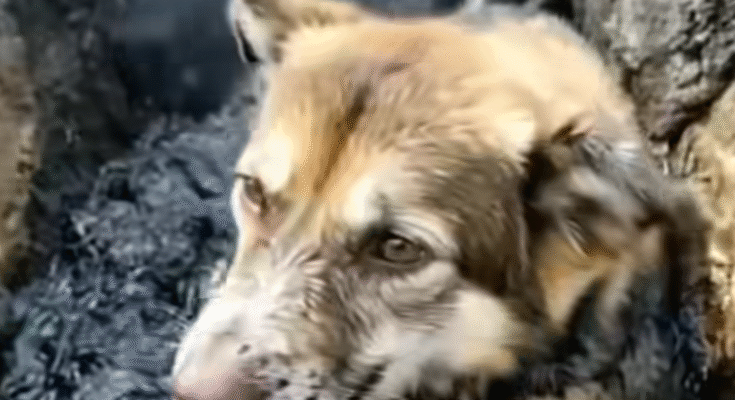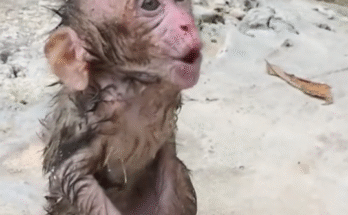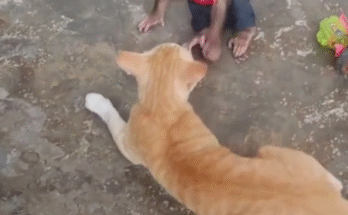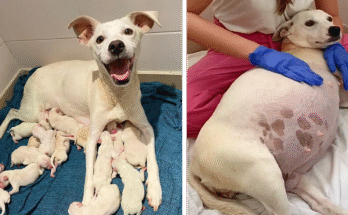Trapped in a Pit of Tar, a Desperate Puppy’s Cries Sparked a Remarkable Wave of Community Support: Uncover the Inspiring Tale of Compassion and Teamwork That Led to Its Rescue
It began with a faint, heart-wrenching whimper.
On the edge of a construction site in a quiet village, a group of schoolchildren playing nearby paused mid-game. They had heard something — not the wind, not a bird — but the unmistakable sound of a creature in distress. Curious and concerned, the children crept closer to the abandoned area where piles of gravel, rusting machinery, and a deep, dark pit of leftover tar sat, forgotten by workers who had long since moved on.
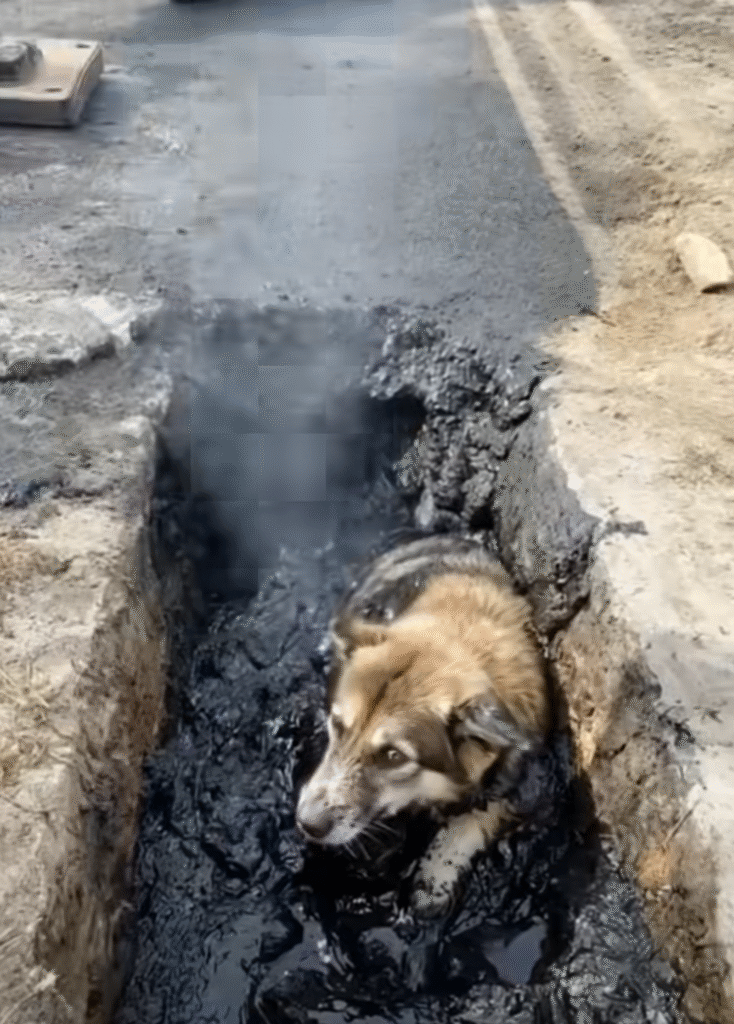
Peering over the edge of the pit, they gasped in horror.
There, struggling helplessly in the thick, sticky blackness, was a small puppy. Its once fluffy golden fur was now covered in tar, stiff and matted, with only its eyes and nose visible above the surface. It whimpered and cried, every twitch of movement causing more of its tiny body to sink deeper. The children screamed for help.
Word spread like wildfire. Within minutes, adults from the neighborhood came running. Farmers, shopkeepers, even a few passing drivers stopped their vehicles to see what the commotion was about. What they saw tore at their hearts — a helpless, innocent life fighting for survival in a silent deathtrap.
Mr. Thom, a retired mechanic known for his quiet demeanor, was one of the first to take charge. He recognized the severity of the situation immediately. “We don’t have hours,” he told the gathering crowd. “If we don’t act fast, this puppy won’t make it.”
But pulling the puppy out wasn’t as easy as it sounded.
Tar is merciless. It grips and holds with an unforgiving strength, and any rough tugging could rip the puppy’s delicate skin. One wrong move, and the poor creature might be hurt beyond saving.
A plan began to take shape. The community, galvanized by the tiny cries and each other’s determination, moved into action.
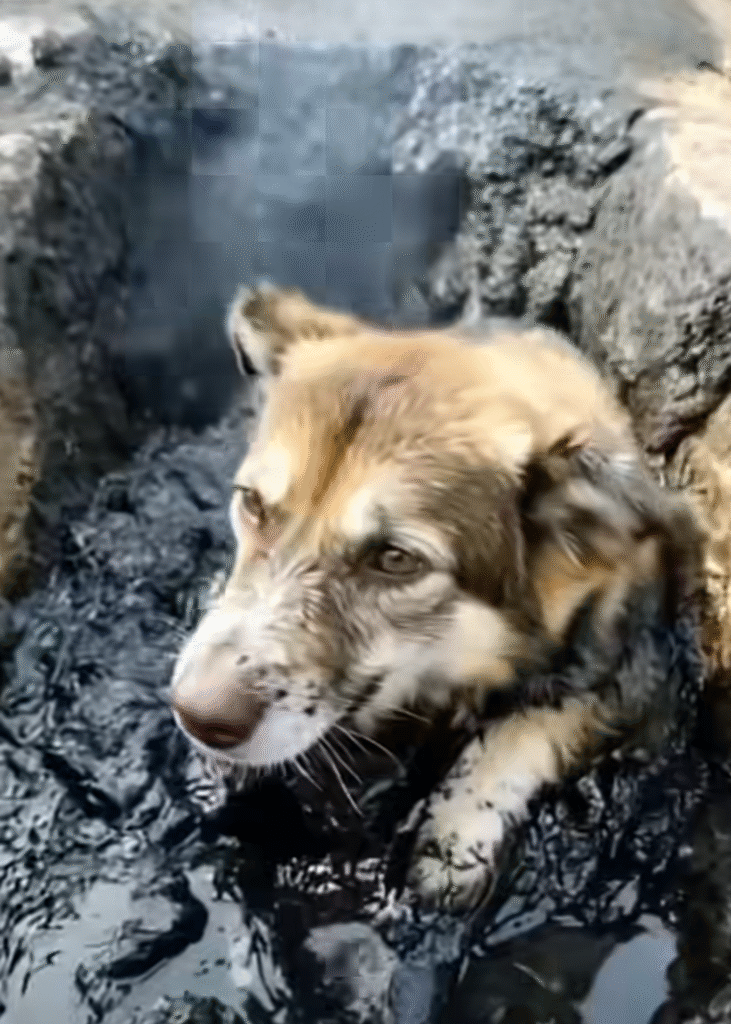
Buckets of warm water were brought in from nearby homes. A few volunteers went to fetch cooking oil, hoping to loosen the tar’s grip. A local veterinarian, Dr. Lan, who ran a small clinic in town, was called and arrived in minutes with her medical kit. She was horrified at the sight, but also deeply moved by the number of people who had gathered to help.
While some carefully applied oil to the visible parts of the tar, trying to break it down slowly, others gently spoke to the puppy, soothing it and keeping it calm. Dr. Lan monitored its breathing, whispering encouragement as if her voice alone could will it to survive.
For two hours, the community labored together.
The process was painstakingly slow. Inch by inch, the puppy was eased out of the pit. Its body trembled, exhausted and overwhelmed, but somehow — miraculously — it held on.
Finally, as the sun began to set behind the village trees, a collective cheer erupted. With the final, careful pull, the puppy was free.
Black and sticky, barely moving, and barely conscious — but free.
Tears flowed freely from adults and children alike. What started as an ordinary afternoon had transformed into a shared mission of compassion, and now, triumph.
Dr. Lan immediately went to work. She wrapped the puppy in warm towels and administered fluids and gentle sedatives. “He’s not out of danger yet,” she warned. “But he has a fighting chance.”
Over the next few days, the story spread across the region — and then across the internet.
Photos of the rescue, of villagers working together, of children holding hands and oil-covered volunteers cheering, quickly went viral. Messages of support poured in from around the world. Donations came in to help with the puppy’s medical expenses. One local journalist called it “a story of hope in a world too often filled with despair.”
The puppy, lovingly named “Lucky” by the children who found him, became a symbol of unity.
As Lucky recovered in Dr. Lan’s clinic, his strength returning and his fur slowly growing back after gentle cleanings, he was showered with love. People brought toys, blankets, and dog food. Local businesses offered to sponsor his long-term care. One family even offered to adopt him — but the village insisted he remain a shared treasure.
Eventually, a decision was made: Lucky would live in the town’s community center, a space open to everyone. He would be cared for by rotating volunteers, always surrounded by the love that saved him. The center, previously used only for occasional meetings, was renovated with the help of donated funds. A small park was built next to it — Lucky’s Garden — a place for kids and dogs to play safely.
But the impact of Lucky’s story didn’t stop there.
Inspired by the rescue, the villagers started organizing monthly clean-up drives. The construction site where Lucky had been trapped was cleared and made safe. Tar pits were sealed or removed altogether. Signs were put up warning others of the dangers of abandoned industrial waste. A volunteer rescue group formed, focused on helping stray animals across the district. What had started as a response to one tiny cry became a movement of lasting change.
And Lucky? He thrived.
In just a few months, the skinny, tar-covered puppy was unrecognizable. His golden fur gleamed in the sun. He ran with boundless energy through the very park built in his honor. He had a favorite ball, a favorite tree, and an army of fans — from toddlers to grandparents.
Visitors came from other towns just to see him. And every time he wagged his tail or gently licked a child’s hand, it reminded everyone of that unforgettable day: when compassion triumphed, when teamwork mattered, and when a single cry for help brought out the best in humanity.
Lucky’s story continues to inspire people far and wide. It’s a reminder that in even the darkest, stickiest pits of life, hope can rise — and sometimes, all it takes is a few kind hearts and the courage to act.
Because sometimes, saving one small life is enough to heal an entire community.
